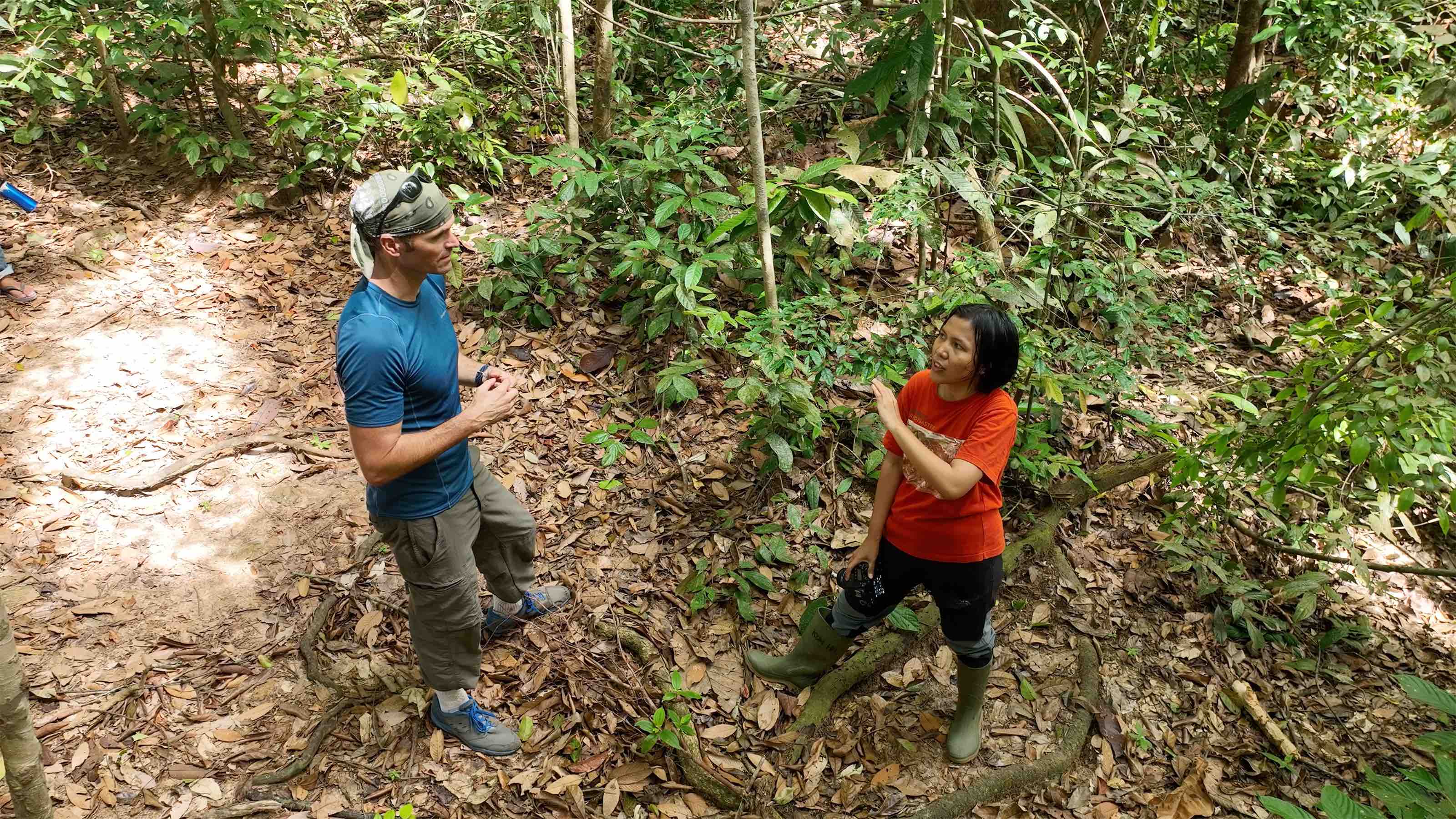Covering climate in the Global South: ideas from Paraguay, Indonesia, Africa and beyond

Mongabay's founder Rhett Ayers Butler reporting on the Harapan rainforest in Jambi on the island of Sumatra in Indonesia.
From devastating floods in Ecuador and Pakistan to hurricanes hitting Puerto Rico and Cuba and a super typhoon in South Korea, some of the most catastrophic consequences of climate change have played out in 2022.
For journalists and newsroom leaders, getting audiences to engage with such a terrifying and ongoing story can be difficult. But audiences in many parts of the Global South can’t turn away: the effects are a daily reality, from food and water crises to extreme heat melting infrastructure and taking lives.
Climate change also exposes global inequalities: the Global North is responsible for 92% of excess global carbon emissions yet nine of the top 10 countries most at risk from climate change are in the Global South. With audiences on the frontlines of the climate crisis, I spoke to journalists covering climate and environment in Paraguay, Indonesia, across Africa and throughout the Global South to know what they are doing to get their reporting across audiences young and old.
Visual journalism rules
According to the World Bank, Paraguay is vulnerable to the effects of climate change: the country has high rates of deforestation and natural resources are unequally distributed. “We pride ourselves on being the country that feeds the world and yet there are people here who are hungry. How is that contradiction possible?” says Jazmín Acuña, co-founder and editor of El Surtidor, a digital news outlet founded in Paraguay in 2016.

Since its launch, El Surtidor (also called El Surti) has focused on land distribution and has tried to figure out how to do it well . “What we were really asking was: how do we do that in a way that’s respectful of our natural resources and makes everyone better off?” Acuña says.
This approach has continued. There’s a “definite overlap” with El Surti’s coverage of gender issues, for example. Women are most affected by deforestation in Paraguay, as those living in forest regions rely on this habitat to feed their families. When the habitat is destroyed or they are removed by businesses, “there’s not just loss of biodiversity, but also food.”
“This crisis can’t be covered just as a news event when there’s a UN conference,” says Acuña. “It’s a multidimensional phenomenon that affects multiple aspects of our lives.”
Shortly before COVID-19, the newsroom assigned one of its four reporters to exclusively cover climate. Having a dedicated climate reporter has improved El Surti’s climate coverage, which tries to connect the effects of climate change with its audience’s lives.
“Environment isn’t just wildlife or biodiversity. It’s extreme heat for delivery workers in cities that get hotter every year if we don’t take care of urban planning,” says Acuña. The newsroom is careful to focus its coverage on those most responsible for the climate crisis in the region and those who can affect policy change and behaviour, rather than on individuals.
Climate stories are business stories
More than 17,000 kilometres away, in Indonesia, Katadata journalist Rezza Aji Pratama is tackling environmental issues through a business lens. As a developing economy, there are numerous infrastructure projects happening in the country. “We are moving our capital – a massive project that will have a huge environmental impact and create issues for Indigenous peoples,” he explains.
In 2021, Pratama investigated the environmental and social impacts of the Kayan River hydropower plant on the Indonesian side of Borneo. In planning since 2013, the reportedly $22.2 billion plant will be the biggest of its kind in south-east Asia when completed. At least two Indigenous villages will be submerged as part of the project, which involves five dams and will have serious implications for the river’s ecosystem.
Previous coverage of the plant had been largely uncritical, says Pratama: “People didn’t talk about what impact there was on the community or the Indigenous people. There was no formal report or academic research on its impact.”
The plant is located in the remote rainforest region of North Kalimantan and can only be accessed by boat, making it an expensive and time-consuming reporting trip. “I’m the first journalist to cover it independently because it’s so expensive,” says Pratama, adding that this media spotlight has opened up coverage by Indonesian media.
Disaster porn doesn’t work
Pratama recently reported on Indonesian companies’ net-zero efforts – again focusing his coverage on the private sector rather than on individuals. Both Pratama and El Surti’s Acuña suggest that documenting how communities and organisations are curtailing damaging behaviours or protecting the environment can engage news audiences.
In Paraguay, coverage of the pollution of Lake Ypacarai, viewed as symbolic in the country, has shown how civil society organisations, government officials and some farmers came together to save the lake.
“We put effort into showing the solutions,” says Acuña. “If we don’t tell the audience the things that can be done, we’re not telling the whole picture and we feed a disengagement cycle. We’re not falling into this narrative that there’s nothing that can be done anymore and we just have to adapt. It’s not true – there is a window of opportunity for change.”
“Disaster porn images in the header” don't work well to engage the audiences of Mongabay, a non-profit conservation and environmental science news platform. “People are kind of burned out by this,” says founder Rhett Butler.
Solutions stories are a viable alternative, but journalists must be cautious of greenwashing. “Doing good solutions journalism tends to be more difficult than doing a standard news article but, when legitimate, it can cut through and reach a lot of people,” Butler says.
Current audiences want to learn and find out how they can adapt to the situation, says Ugandan climate change journalist Fredrick Mugira, co-founder of cross-bordering reporting initiative InfoNile.org and moderator of the 700-strong Water Journalists Africa (WJA) network. Mugira and his colleagues’ audiences are typically rural and their lives and work involve heavy interaction with their environment.
“When farmers have information, they can make decisions and demand change in their communities,” he says. In his recent reporting on the Nile Basin, Mugira looks at how groundwater that supplies people, livestock and wildlife with water is in need of greater environmental protection.
Indigenous peoples know best
Working with Indigenous peoples is crucial to covering the climate crisis in the Global South, according to the journalists I interviewed for this piece. “They were the ones warning us of the climate crisis way before we were talking about it as a society,” says Acuña.
In 2020, Pratama reported on the impact of climate change on clove farmers in eastern Indonesia’s Maluku Province. Cloves are native to the Maluku Islands and have been farmed and stored as collateral by local people for hundreds of years, but a changing climate has made harvests uncertain “They have lived with that knowledge and culture for centuries,” says Pratama. “Now they face a great challenge from the climate to adapt. I have to understand how they react and adapt, their culture and point of view, because it will be very important to get the right story.”
Indigenous communities have vital knowledge regarding adaptation that is under threat, says Mugira. While reporting on the Bwindi Impenetrable Forest in Uganda in 2016, Mugira worked with the Batwa tribe who had acted as defenders of the forest until legislation evicted them from their homes and allowed greater destruction. “When we write stories, it’s important to preserve the community’s traditional knowledge,” he says.
“Mongabay was born around conservation, which has [historically] had a very colonial approach. The Indigenous component in this space has been a gap, but that’s changing,” says Butler. Mongabay has increased its reporting of Indigenous conservation and knows its audience contains decision-makers and funders in the conservation space: “If we could surface more stories about Indigenous-led conservation, we could change how these conservation groups are doing their work.”
Meeting audiences where they are
The focus and format of climate reporting can help reach and engage audiences in the Global South. In a series on deforestation in the Chaco region, a forest ecosystem crucial to South America, El Surti began by publishing an article showing audiences why this area is so valuable and why they should care.
The news outlet has a reputation for strong visual journalism and innovative storytelling techniques and uses this to good effect to engage local audiences with climate reporting. Its guide to COP27 through Taylor Swift lyrics is no exception. Memes help the newsroom connect in a relatable way with audiences bringing their attention to issues that they otherwise might not care about. This Instagram Reel, for example, explains how a past dictatorship gave land illegally to thousands of families in Paraguay – a class of people who have created the current economic model that enables deforestation in the country.
“The size of the unlawful transfer of land to these families is so big that we thought it would be useful to find analogies that mirror the scale. Memes help to get the message across,” says Acuña.
There is an opportunity to build more deeply engaged audiences if newsrooms create spaces to talk about climate issues, suggests El Surti’s Acuña. In addition to workshops and training, InfoNile operates a chatbot on WhatsApp delivering country profiles, groundwater updates and latest news reports. Once a month, El Surti’s team meets with members of its audience to talk about environmental issues and solutions. Around 250 people join a Discord channel to discuss a monthly topic, such as livable cities or lake pollution, with experts, community organisers and activists.
“It’s a space of hope,” says Acuña. “People will stop reading if there’s nothing to be done. This is the most consistent online community work we have done.”
How to report under threat
The climate crisis can be dangerous for journalists, particularly those working under authoritarian or repressive regimes or with a history of state-sponsored violence. In 2021, 200 people were killed defending land and the environment; 1,733 in the past decade. Environment reporters have been killed for their work too with the 2022 murders of Guardian journalism Dom Phillips and his colleague, local Indigenous expert Bruno Pereira, in Brazil, a shocking reminder.
“Covering the climate crisis has become a dangerous job,” Acuña says. “It’s hard to trust the judiciary system. Institutions are weak and when they are weak it means even good legal frameworks to protect forests, communities or safeguard workers will often not be upheld,” A says.
Mongabay spent three years on plans to expand into Myanmar, but then the 2021 coup happened. “We couldn’t be putting journalists in harm’s way in such a dire situation,” says Butler. “There are geographies and countries that just aren’t viable for the journalism that we are trying to do and that’s a sad reality.”
To cover environment stories in such places, Mongabay may work with local journalists and protect identities with pseudonyms or work with journalists from the region who no longer live there. Butler is aware that the risk may be greater for local reporters who may face more threats of violence than an expat journalist in some countries or be at a higher risk of imprisonment or hostage-taking.
Mongabay can create “an enabling environment” in such places by reporting on stories that local newsrooms can’t always take on but who can cite Mongabay’s journalism. “It can lay the groundwork for more reporting while reducing the legal risk,” says Butler. Recent Mongabay reporting on a secret carbon deal in Malaysia, involving the sale of rights to 2 million hectares of land to foreign companies without consultation of the local Indigenous population, was later picked up by local outlets: “I don’t think a local outlet would have broken that story because of its political sensitivity.”
To increase the capacity of localised, environmental reporting around the globe, the non-profit newsroom has launched a permanently endowed fellowship programme for young and aspiring journalists from lower-income and middle-income tropical countries. Up to 12 fellows per year – six working in English and six in Spanish – will report on environmental issues and receive training. The first fellows started last month and the plan is to have two cohorts a year.
Getting reliable data is still a challenge
Beyond safety and security risks, access to data is a critical challenge for reporters in this field in the Global South. InfoNile’s Mugira says he regularly faces out-of-date or irrelevant data, recently when covering plastic pollution in water. Building relationships with local scientists has been crucial to overcome this: “They are now more trusting and willing to give out information and to guide and teach you.”
Accessing data – both from governments and non-political sources – can be difficult and time-consuming. “In my experience, the data is scattered around institutions. It might take months to get,” says Katadata’s Pratama. “You have to have someone you trust giving it to you. Sometimes I even get government data from NGOs because I can’t get access directly from the government. There’s some official data on the hydropower plant that I never got.”
Climate change doesn’t stop at the border and these data challenges are further complicated when reporting across countries. Much of Mugira’s work reporting on water issues is transnational and requires collaboration and data sharing. “The Nile goes through 11 countries,” he says. “Some of those places are transboundary so it’s important for us to bring the story together instead of reporting on these issues solely from the national perspective.”
For most of the countries and governments in the Nile region, water is a sensitive topic, he says, and national interests can override environmental commitments: “They won’t always talk openly, especially those transboundary countries with water boundaries.”
Collaboration is key
Whether for InfoNile or as part of WJA, working collaboratively allows journalists covering the Nile region to pool resources and share notes, ultimately enabling more investigations. “Media houses here are facing a big challenge to fund journalists to do investigative stories,” says Mugira. Both organisations offer mentoring to journalists and grants to fund reporting. Since 2017, this model has allowed InfoNile to train 152 journalists, produce 252 stories and run six cross-border investigations.
With larger media houses struggling to fund investigative reporting in many parts of the Global South, independent newsrooms such as InfoNile and El Surti have grown to fill this gap, particularly in terms of environmental investigations. Funding, however, remains an issue: more than 250 applications from the Nile region will come in for a round of 15 reporting grants from InfoNile, explains Mugira. “They have good stories and pitches but you can’t fund them all,” he says. “Sometimes it’s their media house that doesn’t have the money for this story.”
The best way to build support and funding is to grow the audience for this journalism through rigorous reporting that makes use of the latest data and puts people at the heart of the stories, he says. Attracting young audiences and scientific communities is vital: “We need to train journalists to have the data skills to tell the real [environmental] story and not that of politicians, who are gatekeepers of information and data. When they lack those skills, they can’t report in a way that attracts readers.”
Learn more
- Why we are launching the Global South Climate Database. | Read
- Amplifying the voices of climate scientists and experts from the Global South. | Listen
- Our seminar with Jazmín Acuña. | Read a summary and watch
- Despite growing dangers, reporters are finding new ways to report on the Amazon. | Read
- How local media covered the flooding crisis in Pakistan. | Read







